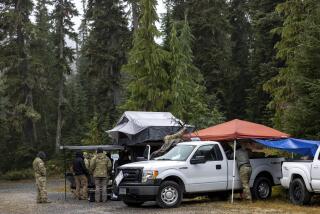7 Killed in Japan Copter Crash Were Tustin Marines
- Share via
Seven Marines killed Saturday when their helicopter crashed onto a fog-shrouded hillside in southern Japan were to have returned home next month to the Tustin Marine Corps Air Station, a base spokeswoman said.
In January, 1987, one of the victims, Cpl. Jason W. Chase of Bayside, Calif., survived a crash of the same type of aircraft, the problem-plagued CH-53D Sea Stallion helicopter, which went down in the California desert near Yuma, Ariz. He was treated for minor injuries at the time.
Chase, 22, and the other dead were members of Heavy Helicopter Squadron 462, stationed at the Tustin air station. They were identified by the Marine Corps as: Capt. Michael E. Bermel, 31, of Cataldo, Ida.; 1st Lt. Patrick C. Fleming, 28, of Bay City, Mich.; Staff Sgt. Stephen R. Yoder, 33, of San Bernardino; Sgt. Eric C. Mau, 28, of Bakersfield; Sgt. Donald R. McKay, 26, of Westlake, Ohio, and Sgt. Jay A. Watkins, 25, of Spirit Lake, Iowa.
Saturday’s was the latest in a series of crashes that have plagued three models of the CH-53 helicopter. Since 1969, the three versions of the aircraft--the A, D and E--have been involved in an estimated 25 major accidents resulting in 186 deaths. The Sea Stallion is a less powerful model of the CH-53E Super Stallion.
Before last year’s crash, the last recorded major accident of a CH-53D was in May, 1985, when a Sea Stallion went down in the Sea of Japan, apparently after the transmission failed.
Lt. Shawn Cooper, public affairs officer at the Tustin air station, said it was not immediately clear whether Bermel or Fleming was piloting the helicopter when it crashed about 10:20 a.m. Saturday. Cooper said one of those two ranking officers would have been piloting and the other co-piloting the craft, which is used to transport both troops and cargo.
The helicopter was crossing the southwest tip of Shikoku Island, just one mile from the Ikata nuclear power plant, when it slammed into the hillside, killing all aboard.
The Marines’ bodies were returned to the Marine Corps Air Station at Iwakuni, 25 miles west of Hiroshima, where the Sea Stallion had taken off 30 minutes before the crash. The crew was on a “routine flight” to the Futemma Marine Corps Air Station in Okinawa, where the craft was based, Marine officials said.
The Sea Stallion plunged into the mountainside shortly after Typhoon Thad struck the area. An hour before the crash, the intensity of the typhoon had decreased somewhat and it had been reclassified as a tropical depression. Meteorologists said skies were cloudy and fog had reduced visibility to 50 or 60 yards at the time of the crash. The downpour Friday and Saturday left four people dead and 16 injured, according to officials in Japan. The typhoon reportedly caused 156 landslides and the flooding of 900 homes before it swept out to sea.
Police in Japan said the crew sent no distress calls from the helicopter, which several news agencies reported to be flying low. Whether the storm was a factor in the fatal crash had not been determined, authorities said.
The Tustin air station has become the major training site for Marine transport helicopter crews destined for duty in the western Pacific. The seven Marines killed Saturday were nearing the end of a six-month tour of duty at Okinawa.
More to Read
Sign up for Essential California
The most important California stories and recommendations in your inbox every morning.
You may occasionally receive promotional content from the Los Angeles Times.













